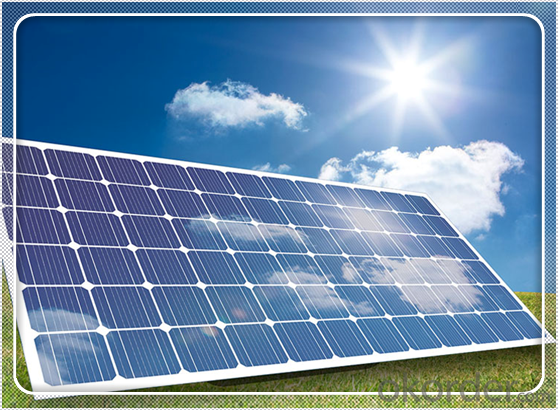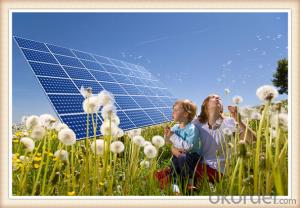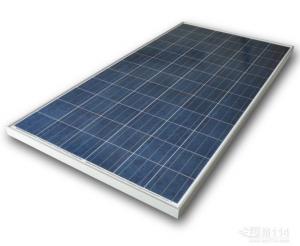Go Power Flexible Solar Panels - 105W Efficiency Chinese Solar Panels 5-200W
- Loading Port:
- China main port
- Payment Terms:
- TT OR LC
- Min Order Qty:
- 10000 watt
- Supply Capability:
- 100000 watt/month
OKorder Service Pledge
OKorder Financial Service
You Might Also Like
Specification




Solar Module Introduction
Solar Module is the core part of solar PV power systems, also is the highest value part of it. The function of Solar Module is to convert the sun's radiation to electrical energy, or transfer it to battery and store in it, or to drive the load running.
The Product has been widely used in space and ground, it mainly used for power generation systems, charging systems, road lighting and traffic signs areas. It could offer a wide range of power and voltage, and with high conversion efficiency, and long service life.
Solar modules use light energy (photons) from the sun to generate electricity through the photovoltaic effect. The majority of modules use wafer-based crystalline silicon cells or thin-film cells based on cadmium telluride or silicon. The structural (load carrying) member of a module can either be the top layer or the back layer. Cells must also be protected from mechanical damage and moisture. Most solar modules are rigid, but semi-flexible ones are available, based on thin-film cells. These early solar modules were first used in space in 1958.
Electrical connections are made in series to achieve a desired output voltage and/or in parallel to provide a desired current capability. The conducting wires that take the current off the modules may contain silver, copper or other non-magnetic conductive transition metals. The cells must be connected electrically to one another and to the rest of the system. Externally, popular terrestrial usage photovoltaic modules use MC3 (older) or MC4 connectors to facilitate easy weatherproof connections to the rest of the system.
Secification
Model Type | |
Peak Power-Pmax(W) | 5-200W |
Open Circuit Voltage-Voc(V) | 44.2 |
Maximum Power Voltage-Vmp(V) | 36 |
Short Circuit Current-Isc(A) | 5.4 |
Maximum Power Current-Imp(A) | 5 |
Maximum System Voltage | 1000V DC |
Maximum Series Fuse Rating | 10A |
Power Tolerance | -1~+3% |
Temperature Coefficients of Pmax | -0.45%/℃ |
Temperature Coefficients of Voc | -0.348%/℃ |
Temperature Coefficients of Isc | 0.031%/℃ |
Nominal Operating Cell Temperature | 44.5±2℃ |
Standard Testing Condition(STC) | Irradiance:1000W/m²;Temperature:25℃;AM=1.5 |
Qualification Test Parameters | |
Operating Temperature | -40℃~+85℃ |
Storage Temperature | -40℃~+85℃ |
Pressure Bearing | ≥5400Pascal/m² |
Wind Bearing | ≥5400Pascal/m² |
Mechanical Characteristics | |
Cell Size | Mono 125*125mm±0.5 |
No.of Cells | 72pcs(6*12) |
Dimension | 1580*808*40mm |
Weight | 15.5Kg |
Glass | 3.2mm High Transmission,Low Iron |
Frame | Anodized Aluminum Alloy |
Junction Box | IP65Rated |
Internal Diodes | 3 Bypass Diodes |
Cable | 1*4.0mm² Length 900mm |
Images
Packing & Shipping:
We have rich experience on how to pack the panels to make sure the safety on shipment when it arrives at the destination.
The normal size is packed by 25pcs/ carton / pallet. Paper carton for FCL shipping and wood carton for LCL shipping.
Warranty:
For c-Si panel: 25years output warranty for no less than 80% of performance, 10 years output warranty for no less than 90% of performance. Free from material and workmanship defects within 5 years.
For a-Si panel: 20 years output warranty for no less than 80% of performance, 10 years output warranty for no less than 90% of performance. Free from material and workmanship defects within 2 years.
FAQ:
(1)What price for each watt?
It depends on the quantity, delivery date and payment terms.
(2)What is your size for each module? Can you tell me the Parameter of your module?
We have different series of panels in different output, both c-Si and a-Si. Please take the specification sheet for your reference.
(3)Can you provide the peripheral products of the solar panels, such as the battery, controller, and inverter? If so, can you tell me how do they match each other?
Actually we are only manufacturer of solar panels, but we could try to source them for you in China if you need. We could provide you an optimal system design to instruct you how to install.
(4)Do you have the CE, TUV, UL Certification?
We’ve already passed all the tests, and any certificate is available.
(5)Have you ever sold your products to companies in my country?
Of course, we have customers in all general PV markets, but I think we should expand our market share along with the market growth.
(6)When did your company set up? You are a new company, how can I believe your quality?
We entered into Solar PV industry in 2005, now we have several plants in manufacturing of a-Si and c-Si panels, and our capacity is 220MW per year. Till now we have already passed all the tests by authorized laboratories, e.g. TUV, VDE, UL.
(7)Can you help us install the module if we cooperate with you?
We haven’t entered into installation sector, but we have the plan in near future.
(8) How do you pack your products?
We have rich experience on how to pack the panels to make sure the safety on shipment when it arrives at the destination.
(9) Can you do OEM for us?
Yes, we can.
(10)Can we visit your factory?
Surely, I will arrange the trip basing on your business schedule.
- Q: I have a small marine solar panel on my boat It came with the boat. I want to make sure it is working before I connect it. With a volt meter It is only reading .2 volts dc. I would think it should be 2-5 volts?
- If it's only reading 0.2 volts, then the panel is burned out. What you can do is look for a nameplate on the panel, then try to look it up on the internet. Hopefully that will say what the voltage is supposed to be. You are right in that a panel intended to charge a 2-volt battery should read about 8 volts open circuit out in daylight, even if it isn't pointing straight at the sun. Is it a flexible rubber panel? Those are notorious for dying after just a couple years.
- Q: Can solar panels be installed in a community or neighborhood?
- Yes, solar panels can be installed in a community or neighborhood. In fact, many communities and neighborhoods are increasingly adopting solar energy as a sustainable and clean alternative to traditional power sources. These installations can be done on residential rooftops, community buildings, or even as shared solar projects where multiple households can benefit from a single solar installation. Installing solar panels in a community or neighborhood not only helps reduce carbon emissions but also promotes energy independence and cost savings for residents.
- Q: I have a home made 24 volt electric cart. It is powered by two 2Volt deep cycle batteries. Since the motor runs on 24 volts the batteries are wired in series to produce the 24 volts. I only have a 2 volt battery charger, but I also have two 2 volt solar panels. It is a pain having to unhook wires, rewire it, or charge them one at the time.HERE IS THE QUESTION REALLY... Can I wire the two 2 volt solar panels together in series (ie: negative to positive) then connect it to the existing 24 volt system and have it charge the batteries fine. I know basic wiring, but I know nearly nothing about solar panels, will it work fine? will it cause them to break? or short out?(additional info, the solar panels are only rated at 5 amps so it will not overcharge the batteries or anything)
- Stephen is sweet in you should adventure the enter criteria of your inverter. so that you'll want to cord a minimum of a few cells in series. probable you should custom-go with a blend of series and parallel for the cells. operating example, if maximum of your fragments grant a million amp, then you actual ought to objective a million amp for the array. If there's a fragment that's 0.7 amp, and yet another that's 0.3 amp, you should parallel those, and count number them as one cellular, that you'll then series with the others. I observed this performed on one individual's panel years and years in the past. It gave the impression of an poor mess, and extremely some artwork, because the cells couldn't be in neat rows, anymore. also, if plausible, you should want the utmost equipment voltage you should use, because meaning decrease amperage for an same potential, and to that end smaller cord. 8 amps, after derating, skill #2 or #4 cord, an same variety that must be used to cord your position. 5 amps skill #0 or #8, and one hundred amps skill a fat cord like the jumper cables for a vehicle. in basic terms so that you comprehend, i trust that's typically unlawful contained in the U. S. to connect a selfmade array to a grid-tied equipment, or to apply a grid-tied inverter that plugs into the wall socket, in case you care.
- Q: Can solar panels be installed on windows or glass surfaces?
- Yes, solar panels can be installed on windows or glass surfaces. These solar panels are known as transparent or semi-transparent solar panels and are designed to allow light to pass through them while still generating electricity. They are commonly used in buildings where traditional solar panels may not be suitable or aesthetically pleasing.
- Q: Ok so I am planning on buying a solar panel. I am doing it to possibly sell the energy that it stores. It is a 20 watt panel so I am just wondering if every week or month if I sold that energy that it stored would make me a good profit. I am not hoping for thousands of dollars a month..just like 00? The solar panel cost me $,00 so if so, how long do you think it would take to make good profit. Also, how much would I make every week or month?
- I will give you the tools to answer your own question. Here is the solar resource map: rredc.nrel /solar/old_data/nsr... Use it to look up the hours of peak equivalent sunlight per day in your area. For example, let's say it's 5 hours / day. Then per year you get 365 x 5 = 825 hours of sun Your panel is 20 watts, or 0.2 kW So the energy produced per year is 825 x .2 = 383 kWh You'll have to use the proper numbers for your own area, of course. Anyway, you can take that 383 kWh and determine how much it would cost at local electric rates. Never know, on some islands, it's $.00 per kWh. Check with your local electric company for rates.
- Q: Can solar panels be installed on a mobile home?
- Yes, solar panels can be installed on a mobile home. Mobile homes can benefit from solar energy just like any other type of home. Installing solar panels on a mobile home can help reduce energy costs and increase energy efficiency.
- Q: I am planning to run a couple of dc motors on solar current. I have a couple of 450mA 4V, 200mA .5V, 00mA 9V solar panels with me. I need to run a pair of .5A 9V motors. Suggest me a circuit along with other equipments I might require. For your info, I am trying to build a solar powered drone / UAV
- I don't think it is enough solar power. Your motor requires .5A x 9V = 3.5 watts. The solar cells are .450A x 4V x 2ea. = 3.6 watts, .2A x .5V = .3 watts, .A x 9V = .9 watts total solar = 4.8 watts. The problem with connecting the cells in series to get the right voltage, like the two 4V cells in series with the .5 volt cell (total 9.5 volts) is that the .5 volt cell limits the maximum current to only 0.2A. If you paralleled that with the 9V cell, you would get 9 volts at 0.2 + 0. = 0.3A, too low to operate the motor at its design current and voltage. The best you could do is put the two 4V cells in series, and in parallel with the 9V cell (a blocking diode might be a good idea, but probably not required for such a small array). That way you get 8 volts at 0.55 amps.
- Q: And how do you choose the best one for the best price?I saw a 400 watt monocrystalline solar panel
- The polycrystalline solar panel has a longer life-span and has a higher efficiency. What this means is that from the energy that 'hits' the solar panel, more is caught and used to convert into electrical energy. A polycrystalline solar panel will have an efficiency of about 4%. The monocrystalline solar panel has a similar efficiency but the cells are prone to sunlight, so the efficiency drops over the years.
- Q: What is the most efficient solar panel, how many would we need to power the United States, and how much land would it take?
- Annual power consumption in the US is approximately .2*0^5 Watt-hours. The average solar panel can generate 80W continuously. We can break up the calculation into parts: .2*0^5 Watt-hours per year 925 hours per year .3*0^ continuous watts 80W per panel 64383566 panels 000 sq. inches average solar panel area 650 million square miles (!!!) To give you a better idea, the total surfacre area of the United States of America is 3 million square miles. The surface of the earth is 96 million square miles. Not even 3 planets full of solar panels would be enough. Maybe it is easier for people to start using electricity more responsibly?
- Q: Can solar panels be installed on a balcony or terrace?
- Yes, solar panels can be installed on a balcony or terrace as long as there is sufficient sunlight exposure and structural support in place to hold the panels securely.
Send your message to us
Go Power Flexible Solar Panels - 105W Efficiency Chinese Solar Panels 5-200W
- Loading Port:
- China main port
- Payment Terms:
- TT OR LC
- Min Order Qty:
- 10000 watt
- Supply Capability:
- 100000 watt/month
OKorder Service Pledge
OKorder Financial Service
Similar products
Hot products
Hot Searches

























